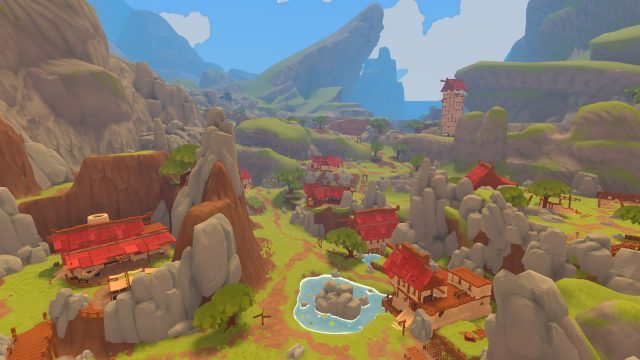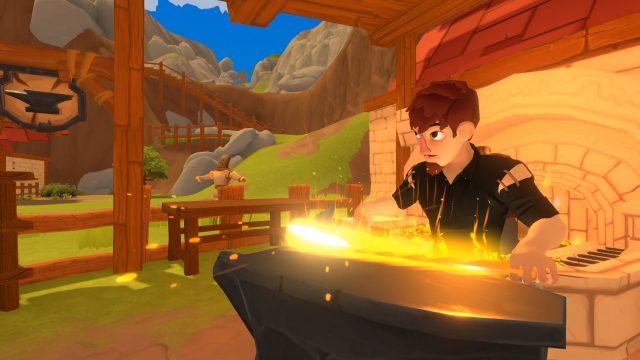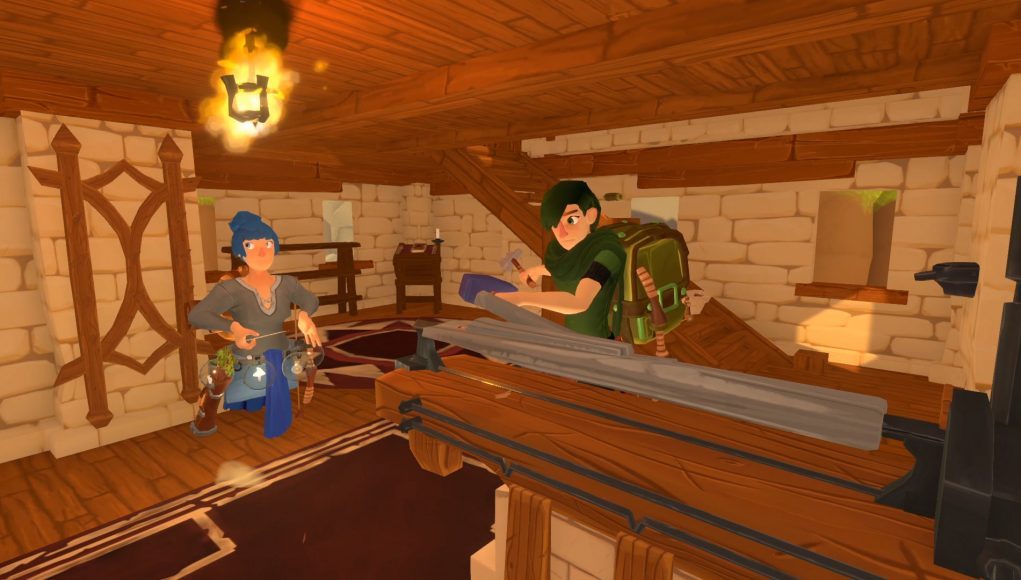MMO-like A Township Tale has been available on PC VR for a few years now, but today’s launch on Quest opens the game up to a whole new audience. With support for up to eight simultaneous players and immersive interactions at its core, there’s nothing else quite like A Township Tale out there.
A Township Tale Details:
Available On: Oculus Quest & PC VR
Price: $10 (Quest), Free (PC)
Cross-play: No (planned for future)
Developer: Alta
Release Date: July 15th, 2021
Reviewed On: Quest 2
ℹ A Township Tale is free-to-play on PC but costs $10 on Quest. However, the Quest version includes 1,000 Talems (the in-game currency for premium cosmetics) and the ability to run your own server (which on PC costs $10 per month).
Gameplay
On its face, Township Tale is a game about finding an abandoned town and working together with friends to fix it up and create a functional community. Along the way there’s tons to explore and discover. Not just the world around the town, but the game’s breadth of mechanics and professions like cooking, mining, blacksmithing, carpentry, and more.

Township Tale is very open-ended; there is no explicit story or quest structure. The game starts you off with a tutorial of the absolute basics. It’s up to you—and your compatriots—to figure out the rest. At its best, discovering how the world works is a blast. Every time you find a new item, area, or learn how to make something new, it feels like the world is expanding before your eyes.
While some parts of the game—thanks to fairly intuitive immersive designs—offer that thrill, other parts can feel obtuse and frustrating. Players who are not patient and persistent will likely tire of Township Tale quickly for this reason. And while you could certainly opt to look everything up in the official Wiki, discovering it together is really the heart of the game.
Whether or not you have friends to share in the highs and lows of discovery and adventure will likely play a significant role in your enjoyment of the game. While any number of players can ‘belong’ to a server, up to eight can be connected at once on Quest. Cross-play with PC isn’t supported, but developer Alta says it expects to add this in the future.
Township Tale’s avatar system has great customization thanks to a wide range of options, including the ability to pick the color (and often secondary color) of pretty much anything you can customize on your character. Figuring out how to save your avatar and apply it before joining a server can be pretty confusing on the first run, but it works pretty well once you understand it, and supports 10 different avatar outfits which you can swap between.
While Township Tale might be missing the ‘massive’ part of ‘massively multiplayer online’ (MMO), it definitely has that MMO-like feel of adventuring around a persistent world that everyone is contributing to. I can’t imagine playing the game solo (nor would I recommend it); there’s a ton to do and a lot to learn; you’re going to want some friends to share the load, otherwise much of the game could feel like a tiresome grind.
While there’s also lands to explore and enemies to slay, Township Tale’s crafting professions really steal the spotlight. Gathering resources to build things is usually the motivating force behind what you decide to do in the game.
If you want to make a sword, for instance, you’ll need to mine ore. To mine ore you’ll need to make a pickaxe. To make a pickaxe you’ll need to learn carpentry to make a handle. To make a handle you’ll need wood. To get wood you need to chop down trees. Etc.
While the lack of tutorialization can be frustrating at times, it encourages communal knowledge transmission that often plays out much like a master & apprentice. This is supported by the game’s rich player-to-player interactions (covered in more detail in the Immersion section).
As you get more experienced with the game’s various professions, you’ll be able to become even more specialized in that profession by learning new skills at special shrines hidden throughout the world. I don’t want to get too deep into all the skills—after all, discovery is one of the most fun parts of Township Tale—but learning these skills feels like a direct sense of progression in the game, and a reflection of the role you’ve chosen to take.
While out looking for resources, you’re likely to come across enemies. Unfortunately combat in Township Tale is perhaps the game’s weakest component. It feels very ‘first-gen’ in terms of VR combat; which is to say it’s largely an awkward affair due to enemies hardly responding to your hits and there being little room for strategy beyond ‘hit them until they die’.
This is a bummer considering the range of player-made weapons available in the game. There’s bows, swords, axes, spears, daggers, maces, throwing knives, dynamite, and even a slingshot.
And, thanks to the flexible crafting system, you can build interesting variations on those weapons. For instance you could easily whip up a halberd (a spear & axe combo) by combining a side-facing axe head and a top-facing spear tip onto a long handle. Or you could make a double-ended polearm, a battle axe, or an axe-hammer. Hell, you could even make a flaming torch-axe.
Like the professions, the ‘town’ of Township Tale has a surprising amount of depth to it. At the start most buildings will be in some state of disrepair and you’ll need to gather resources to build them up to their full potential. Eventually you’ll find your own personal lockbox and bank where you can store valuable items and coins that only you can access. There’s even vending machines in town which you can use to sell items to other players when you aren’t around. You put in your inventory, pick the price, and then collect the earnings when you get back.

Any time you sign onto Township Tale it feels like there’s 20 things you could be doing. Because it’s so open-ended, your enjoyment of the game will be very reliant on having friends to play with regularly, and your ability to focus on one objective (ie: gather ore to make a weapon or upgrade a building) and work diligently toward it without getting sidetracked. The game can feel like ‘work’ at times, given how long it can take to accomplish larger goals, so pick your objectives carefully.
Township Tale doesn’t have an explicit ending, so there’s no amount of time that constitutes the ‘end’ of the game. Your progression will be heavily dependent on whether you choose to look up information and whether or not you’re learning from seasoned players or learning everything as you go.
I’ve played the game for more than 10 hours; part of the time I played on an ‘unlocked server’ which let me experience more of the game in a compressed time. Even at this point it feels like there’s tons more for me to discover and craft. But I’ve gotten a strong feeling for the foundation of the game and where the core fun lies. There is some end-game-ish content, but it isn’t in the Quest version of the game at launch.
Immersion
Immersive player-to-player interactions in Township Tale make for a certain kind of social VR magic that’s hard to come by elsewhere. Nearly every interactive object in the game is physics-driven and networked between players. This means you can hand items to others, work together while crafting, fighting, managing inventory, etc.
There’s something special about holding out a torch toward your friend while they spark it alight by clacking two flint together before getting out their own torch to light it from yours.
This kind of cooperation is really where Township Tale shines, and opportunities for it are abound, especially in crafting. Blacksmithing, for instance, is a multi-step process that involves different tools and resources. Tossing a bag of coal to your friend and asking them to load it into the furnace while you load the ore into the hopper feels entirely natural thanks to the immersive crafting design.
You’ll likely find yourself asking your friend to hand you a tool or hold something for you while your hands are full doing something else. The game’s interactive and cooperative nature opens opportunities for benevolent helpfulness (or trolling, depending upon which kind of friends you have) and resource sharing which aren’t possible in some other games due to limitations in cross-player item interactivity.
This is all underpinned by an inventory system which, while frustrating at times, is smartly designed for immersion and usability.
On your back you’ve got a backpack with a handful of item slots and four additional item slots around your belt. If you have spare room in your backpack, you can put items over your shoulder and they’ll drop into an open slot. Or you can pull your pack off of your back to see everything inside and move things between your belt and backpack.
The developers have also came up with a smart system for handling ‘stacks’ of items. By default if you pull and item out of a stack of items, you’ll just grab a single item. But if you hold the grab button over the stack for a moment it will turn into a ‘pouch’ which holds all of the items in the stack. This makes it easy to move large stacks of items around your inventory, to other players, or into storage.
You can easily pull individual items out of pouches, or long-hold to split the pouch in half, with one half in each hand; using the thumbstick you can transfer items between pouches to change the stack sizes. It’s a smart, flexible system which makes working with large stacks of items easy and intuitive.
And, as with the rest of the game, your inventory and backpack are interactive between everyone. It isn’t your character’s backpack; it’s just a backpack you happen to be wearing. If you took it off and left it sitting in the woods, another player could come along and pick it up, loot your entire inventory, or take the entire backpack with them. Luckily people can’t steal items if you’re wearing the pack, but if you hold it out to them they can even place items into it for you (great when your hands a full!).
While there’s a lot of immersion that comes from this level of player-to-player interactivity, there’s an undercurrent of jankiness that tempers the overall level of immersion in Township Tale.
Object physics can sometimes be spotty, with items jumping about under the influence of invisible forces when dropped. Grabbing some items can be annoying due to a limited amount of grabbing points, and it can be difficult to get a tool into the right position to feel like you’re holding it at the proper angle (for instance, holding a chisel and a hammer). If you want to make a small adjustment to the grip of your tool, you usually need to set down whatever is in your other hand and then use both hands to make the adjustment (trying to toss it up and re-catch it with one hand usually leads to frustratingly dropping your tool to the ground).
Weapons also don’t feel great to swing given how enemies hardly react to the damage they’re taking. It isn’t clear how much you really need to swing for a successful hit, nor is it clear how much damage you’re dealing or how much is being dealt to you.
While the game’s immersive menus (like the server selection menu) are more interesting than their laser-pointer counterparts, they aren’t always intuitive and are often designed with the expectation that the player has a lot of space to physically walk around. They would definitely benefit from a redesign which reduces their footprint and aims for a bit more clarity.
Unfortunately Township Tale on Quest has a near-persistent performance-related stuttering issue which is especially apparent in your hands and when using tools. It’s hard to imagine this is the expected behavior, so hopefully something can be done about it post-launch.
The stuttering seems to impact the game’s physics which sometimes cause you to miss strikes (ie: when hitting something with a hammer) or can cause your tool to clip through an object and get stuck inside of it.
Comfort

Township Tale includes both smooth locomotion and teleportation. And although teleport is the default on Quest, it feels like the game has been built primarily around smooth locomotion, especially considering the way that combat plays out and that the teleport implementation doesn’t seem well-tuned for traveling long distances as one often does in the game.
There are plenty of VR games that I can play comfortably with smooth locomotion, however Township Tale isn’t one of them. It may be related to the fact that there’s a long acceleration curve when movement starts and stops. Luckily I could play comfortably with teleport even for sessions of an hour or more.
While the game generally doesn’t have any intentional lurching moments (ie: taking control of the player’s head), this can happen accidentally if you lean over a slightly raised surface. For instance if you lean your head over a small step, the game will consider that you are now on the step and raise your viewpoint accordingly. If you are merely leaning to reach for something, this sudden change in height can be uncomfortable, especially when it happens repeatedly (I found several instances of this while blacksmithing).
The aforementioned performance-related stuttering issue definitely adds a level of discomfort when you are looking at your hands or interacting with objects. It also makes smooth turning feel choppy and potentially uncomfortable even for those who would normally prefer it.
A Township Tale Comfort Settings – July 15th, 2021 |
|
Turning |
|
| Artificial turning | ✔ |
| Smooth-turn | ✔ |
| Adjustable speed | ✔ |
| Snap-turn | ✔ |
| Adjustable increments | ✖ |
Movement |
|
| Artificial movement | ✔ |
| Smooth-move | ✔ |
| Adjustable speed | ✔ |
| Teleport-move | ✔ |
| Blinders | ✔ |
| Adjustable strength | ✔ |
| Head-based | ✔ |
| Controller-based | ✔ |
| Swappable movement hand | ✔ |
Posture |
|
| Standing mode | ✔ |
| Seated mode | not explicit |
| Artificial crouch | ✖ |
| Real crouch | ✔ |
Accessibility |
|
| Subtitles | n/a |
| Languages | n/a |
| Alternate audio | n/a |
| Languages | n/a |
| Adjustable difficulty | ✖ |
| Two hands required | ✔ |
| Real crouch required | ✔ |
| Hearing required | ✖ |
| Adjustable player height | ✖ |







